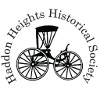Benjamin A. Lippincott, in 1890, was allowed to construct a passenger station in the center of his land for the Atlantic City Railroad Company. Then, Lippincott, with Charles Hillman, filed a grid street plan with Camden County to develop a community. They named it Haddon Heights because of its proximity to Haddonfield and its high elevation.
Large, comfortable, Princess Anne four squares and colonial revival type houses were constructed that appealed to prosperous middle class families moving from the cities. By 1904, Haddon Heights was large enough to incorporate as a borough and proceeded to elect Lippincott mayor. A small downtown grew near the railroad and the White Horse Pike and eight churches and a synagogue were built.
An area of old Center Township, known as Fairfield Estates, voted in 1926 to become part of Haddon Heights. This land was developed for more single family housing through the 1940s and 1950s. Even though rail passenger service ceased in July 1965, Haddon Heights remains a typical turn of the 20th century railroad suburb with tree-shaded streets and comfortable homes that still “appeal to the inhabitants and the observer as being of a class bordering on, if not quite, exclusive.”
Source: Adapted from the Haddon Heights Borough Website.
BOROUGH HISTORY
Timeline of Haddon Heights
|
1690s
|
1699 · John Hinchman arrives in town; oldest portion of the Hinchman-Hurley House constructed
|
|
1770s
|
1770s · First Glover Mill constructed
|
|
1850s
|
1823 · First Glover Mill burns down
|
|
1850s
|
1853 · “Poor’s Burying Ground” cemetery moved from Newton Township to present-day Kings Highway and First Avenue
|
|
1860s
|
1865 · Boundary established separating Haddon and Centre townships, crossing the White Horse Pike around Garden Street.
|
|
1870s
|
1876 · Railroad line opened through Heights to Atlantic City
|
|
1890s
|
1890 · Train station built
1890 · Haddon Heights Inn built
1897 · Catholic & Baptist Churches open
1898 · Evaul Brothers open a general store at the corner of Station & White Horse Pike
|
|
1900s
|
1902 · Haddon Heights Library established; first housed with the YMCA at 600 Station
1904 · Borough incorporated
1904 · Benjamin A. Lippincott becomes the first mayor
1904 · First meeting of the Fire Department
1904 · Haddon Heights Herald first published
1905 · Movie theater opens
1907 · First dentist’s office opens
1908 · Borough hall dedicated
1908 · First National Bank of Haddon Heights erected
1908 · Trolley line extended into town
1909 · Fire company moves into Municipal building
|
|
1910s
|
1910 · Haddon Heights High School graduates its first class
1911 · M. Albert Evoy is the town’s first undertaker
1911 · Sewage disposal plant built
1914 · Seventh Avenue School (then known as the “No. 2 School”) opens
1917 · Glover fulling mill torn down (foundation can still be seen in the park)
|
|
1920s
|
1921 · White Horse Pike paved
1923 · Haddon Heights Inn demolished
1924 · Current High School building opens
1924 · Movie theater reopens
1925 · Fire department moves into its own building
1926 · Fairfield Estates becomes part of the borough
1924 · Station Avenue widened
1927 · Concrete & steel Kings Highway bridge constructed over the tracks
1929 · Baptist Church burns down
|
|
1930s
|
1935 · Post Office built
|
|
1940s
|
1947 · Boundary with Haddonfield relocated
|
|
1950s
|
1951 · Boundary with Haddonfield again relocated
1951 · Glenview Avenue School built
1952 · Current sewage disposal plant built
1954 · Addition to High School approved
|
|
1960s
|
1961 · Haddon Glen built
1963 · Atlantic Avenue School opens
1965 · New Borough Hall constructed
1965 · New town library constructed
1965 · Railroad passenger service ceases
|
|
1970s
|
1976 · Stanfill Towers built
|
|
2000s
|
2004 · Centennial of the town’s incorporation
|
